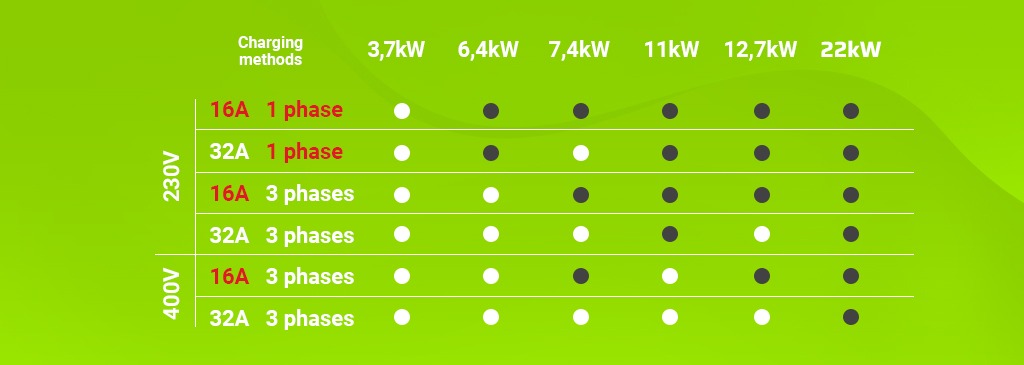A purchase of an electric car is the beginning of a new adventure! Before you set off on the first journey you should assimilate information about charging your car, charging phases, get to know what you can do and what to avoid. That’s why we have gathered the most important aspects concerning cables for charging the EVs. Here you will find everything you need to know about them.
With this article you will learn:
- what are the characteristics of Type 1 and Type 2 cables,
- what does the cable for charging EV have in common with water hose,
- what is the difference between single-phase and three-phase charging.

Type 1 and Type 2 cable – which one should I choose?
The cables for charging an electric car can come with two main types of plugs – Type 1 and Type 2. It is easy to check which one will be compatible with your car, because all European cars produced after 2019 have Type 2 plugs. If you are not sure which of them will be right, it’s good to check the specification of the cable before the purchase – usually there is a list of cars compatible with a given plug.
The cables with Type 1 and Type 2 plugs differ in terms of charging possibilities. The first of them operates with only one phase, whereas the second one is adapted to all three phases. It means that it will be able to charge faster than Type 1 cable.
It is also a matter of the cord used and parameters with which a given electric car model can be charged. Unfortunately, not every EV is capable of reaching the power at the level of 22kW. Before buying the cord handling given power, check what is the maximum charging for your car (in amperes). Buying a higher wattage cable will not allow you to charge your car faster. That’s because your car isn’t set up for higher charging rates.
What does the cable for charging EV have in common with water hose?
I guess you have read this heading and you expected to hear a “chestnut” – but actually it is not the case! Surprisingly a cable for an electric car and a water hose have many things in common, so we made this comparison deliberately. Thanks to this comparison it will be easier for you to understand how these accessories work, because many aspects can be illustrated with the use of water.
Water hose diameter = current (ampere)


Water hose diameter indicates the quantity of water which can flow through it, which is the capacity. The similar case is with the charging cable. Its diameter has an influence on the current strength (amperes) at which a car can be charged.
Tap = voltage (volts)


The tap determines the pressure which should flow in the water hose. In the case of the charging cable the role of “pressure” is taken up by voltage (volts). We can distinguish supply compatible with 230V and 400V. The second type of charging is possible in the case of cables having low power, such as 3.6 kW.
Number of hoses = number of phases
The more water hoses, the more liquid you can get at the moment of unblocking the water spout. This is quite logical relationship, which also works in the case of charging cables. Single-phase cables have only one cord, which supplies energy, whereas three-phase cables have two additional cords.
And what about kW (kilowatts)?
When using greater number of cords, i.e. three-phase cables, you will be more satisfied with the speed of charging your electric car than in the case of using single-phase cables. Unfortunately, high power values (kW) are not possible to reach when choosing single phase (the lowest possible charging with three-phase cables amounts to 11kW and applies to 16A).


A sample interpretation: In order to be able to charge a car with the power of 22 kW we need to power it using 3 phases (which points to Type 2) with 32A.
Summary
We have presented the most important information about charging electric vehicles. We hope you managed to systematize your knowledge on this subject and now you know which cable you should choose. If you still have doubts, feel free to contact our specjalists. We will be happy to check which of our accessories will be compatible with your electric car and we will help you choose the right product!
Alexandra Smith
Related posts
Most viewed entries
- Polish Inventors Who Changed the World – Do You Know Them All?
- The Scariest Myths About Electronic Devices – Halloween 2024
- The history of bicycle – International Bicycle Day
- Electricity in a camper van on holiday – a conundrum easily solve
- Off-grid installation on a plot. Is it worth it?
- Charging your electric car at home without a wallbox

